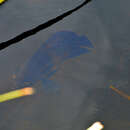ar
الأسماء في صفحات التنقل


Perception Channels: tactile ; chemical
---
As a popular aquarium fish, A ocellatus has some obvious economic importance to humans. Additionally, it has been used by biologists in numerous studies of fish, including studies on behavior, eyesight, auditory systems, and swim bladders.
Although these predators are not at all choosy, they feed mostly on insect larvae and smaller fish. Their feeding habits require that Oscars have excellent eyesight. Because of this, they have been the subject of numerous studies concerning eyesight in fish. (The Aquarium Encyclopedia, 1983, Andison and Sivak, 1996)
These fish are found in the Amazon River basin, from the Orinoco River to the Rio Paraguay, throughout Venezuela, Guyana, and Paraguay. (The Aquarium Encyclopedia, 1983.)
Biogeographic Regions: neotropical (Native )
Found in the tropical lowlands of South America, A. ocellatus prefers the floodplains and swamps of the Amazon River basin. They are most comfortable in water about 25 degrees Celsius, or slightly higher for breeding. (Kullander, 1996)
Aquatic Biomes: rivers and streams
Compared to other fishes, Astronotus ocellatus has a slender, laterally compressed body, and a blunt head with a large mouth and protruding jaw. Colors vary greatly among geographic regions and individuals, but most are dark green to black, with red stripes along its back and a red circle on the base of the tail fin. The adult fish grows up to 35 cm long. Males and females are visually indistinguishable. (Gracyalny, 1996.)
Range mass: 2 to 4 kg.
Other Physical Features: bilateral symmetry
Though they can become much larger, A. ocellatus are sexually mature soon in life, usually by the time they are 12 cm long. These fish exhibit a high degree of parental care. After spawning in open water, the eggs are laid on a piece of ground that has been cleared by one of the parents. After three or four days, the eggs hatch. The brood is then transported to a sandy hollow for about one week. Young fish have been observed clinging to their parents with their mouths, even after they are able to swim freely. (The Aquarium Encyclopedia, 1983)